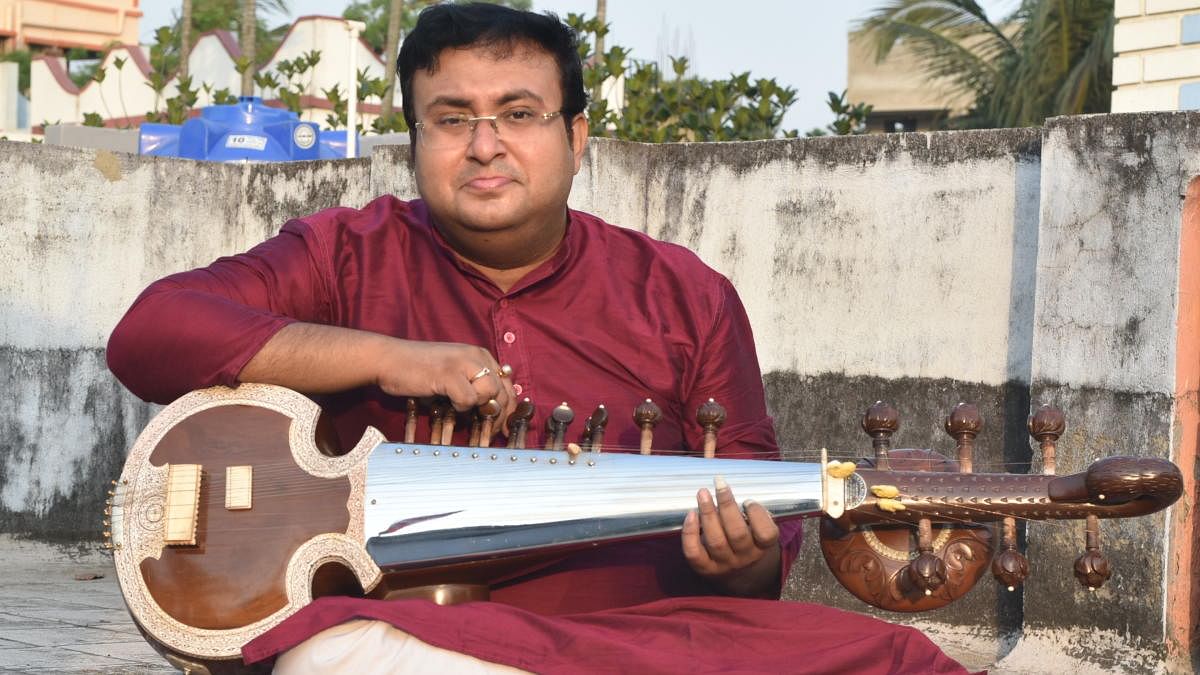

Two interesting musical instruments, that had almost been forgotten for decades, have been remade with subtle changes in design. Mingled with modern sound gadgetry — the revived Radhika Mohanveena and sursingar — are not prototypes of the actual.
These indeed sound better, claims Kolkata-based multi-instrumentalist Joydeep Mukherjee, who took up the challenging experiment.
The instruments have an interesting past, like the instrumentalists. A young sarod player, Radhika Mohan Maitra got an opportunity to play jugalbandi with maestro Ustad Sadiq Ali Khan at a concert in Lucknow in undivided India. Sadiq was on the veena, while Maitra played sursingar.
A complete musical performance required two instruments — a sursingar for alap-jor-jhala (sections in a melodic framework, raga), and a rabab or sarod for gat (the last section). Maitra was well acquainted with sarod and sursingar — an instrument with heavy sound and low base. The Lucknow concert, however, made him realise the limitations of sursingar — humongous, difficult to travel with, and a dwindling base of craftsmen who made it.
Maitra designed an instrument that would have a soothing sound like that of sarod, a tonal quality of veena, and high resonance of sursingar in 1948.
At the All India Radio — where he performed 1952 onwards, and continued till 1976, producer Thakur Jaidev Singh named the instrument after the designer, and thus Radhika Mohanveena was born.
Mukherjee, who has been receiving his talim (education) from Maitra’s disciple Pranab Kumar Naha since 1987, saw photographs of the Radhika Mohanveena and learned more about it through writings, for the first time in 2002.
The idea to revive the instrument was experimental. Mukerjee at first got a rabab remade, but it failed to offer the desired sound quality.
The understanding was that it was a mix of sarod and surbahar with slight modifications — the soundbox’s front is made of wood instead of having a cover made of a piece of hide; and a bridge of surbahar.
“The Radhika Mohanveena is kept at Sangeet Natak Academi. With permission, I was able to take dimensions of it — the lengths and ratios. To remake it, I had to think like its maker. I was trying to convert a sarod, till I realised Radhika Mohanveena is an evolved instrument,” Mukherjee said.
The design for the revived instrument was ideated with one important consideration in mind — the instrumentalist. Keeping the ratios between dimensions intact, a longer Radhika Mohanveena — 46 inches, instead of the original with the length of 40 — was designed.
An engineer by training, Mukherjee was conscious of the fact that sound reflects best on a rough surface. Accordingly, the maker was instructed to keep the inner surface of the sound box (tabli) as rough as possible so that sound reflections offer good resonance.
In the revived version, a touch mike is attached to the sound box.
A sound of very low frequency also gets picked. The mike is connected to a mixer where the sound gets filtered and a quality result is achieved through the attached speaker. A lag of a few nanoseconds indistinguishable to the human ear, occurs. The strings used are thicker than that of a sarod. A stainless steel plate is also an addition.
Mukherjee performed on the remade instrument at a music festival in Varanasi in 2020.
Work on sursingar – now rarely used in performances — began next. The maker who recrafted Radhika Mohanveena, says Mukherjee, wasn’t eager for a second experiment. The instrument has been mostly away from public performances.
A new craftsman was ready to remake sursringar with Mukherjee’s design instructions. The 18-inch tabli cross-section was reduced by two inches. Instead, its depth was enhanced and a gourd shell — like in a surbahar — replaced the wooden sound box. To gain resonance lost with this change, sympathetic strings were added. The new version — developed last year — could be used for playing a complete musical performance.
Mukherjee played the instrument in a Varanasi event this year in February. In March, he used both revived instruments in a concert in New Delhi.